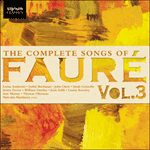Albert Samain’s collection
Au jardin de l’Infante (1893) was given to the composer by his mistress Emma Bardac, the singer who had been the dedicatee of
La bonne chanson earlier in 1894. Following on from the poem
Larmes (which Fauré set as the duet
Pleurs d’or),
Élégie has nine strophes of which the composer selected the last three. The form is ABA broadly speaking, but like the great modified strophic songs at the end of Schubert’s life nothing is taken for granted – the music is continually rethought and newly invented. The accompaniment for this nocturne begins modestly in simple semiquavers (like Verlaine’s
En sourdine), flowers into almost dizzying complexity in the second strophe, and deftly returns to a single stave at the beginning of the third (the ardent harmonic subtleties leading to this last transition are simply miraculous). In another Verlaine setting,
C’est l’extase (1891), we have heard ‘le frêle et frais murmure’ of nature; musical imagery for almost inaudible sound returns in Soir, set off by the words ‘entends-tu pas quelque chose mourir?’. In both cases a delicate descant to the vocal line is traced in the little finger of the right hand; this is supported by off-beat mezzo staccato harmonies that change constantly, glinting and palpitating. This is a kind of musical pointillism, prickly in close-up, but blurring into a marvellously glowing picture from a distance. The final bars (‘si tristes et si doux’ followed by the postlude) encapsulate both the depth and economy of Fauréan expressiveness.
from notes by Graham Johnson © 2005
Fauré se vit offrir
Au jardin de l’Infante (1893), le recueil d’Albert Samain, par sa maîtresse Emma Bardac, dédicataire de
La bonne chanson (1894).
Élégie, qui fait suite au poème
Larmes (dont Fauré fit le duo
Pleurs d’or), compte neuf strophes, dont seules les trois dernières seront mises en musique. La forme est grosso modo ABA mais, à l’instar de ce qui se passe avec les grands lieder strophiques modifiés créés par Schubert à la fin de sa vie, rien n’est acquis : la musique est constamment repensée, réinventée. L’accompagnement de ce nocturne débute modestement par de simples doubles croches (comme
En sourdine, sur un poème de Verlaine), pour s’épanouir en une complexité presque étourdissante dans la deuxième strophe et revenir habilement à une seule portée au début de la troisième (les ardentes subtilités harmoniques menant à cette ultime transition sont tout simplement miraculeuses).
C’est l’extase (1891, sur un poème de Verlaine) nous a donné à entendre le « frêle et frais murmure » de la nature ; cette même image musicale d’un son presque inaudible revient dans Soir, déclenchée par les mots « entends-tu pas quelque chose mourir ? ». Dans les deux cas, un délicat déchant de la ligne vocale est dessiné par l’auriculaire droit, soutenu par des harmonies mezzo staccato sur les temps faibles, constamment changeantes, étincelantes et palpitantes. C’est une sorte de pointillisme musical, hérissé de piquants vu de près, mais qui se fond en un tableau merveilleusement éclatant vu de loin. Les mesures finales (« si triste et si doux » suivi du postlude) résument et la profondeur, et l’économie de l’expressivité fauréenne.
extrait des notes rédigées par Graham Johnson © 2005
Français: Hypérion


 Fauré: The Complete Songs, Vol. 3
Fauré: The Complete Songs, Vol. 3
